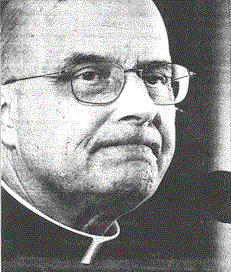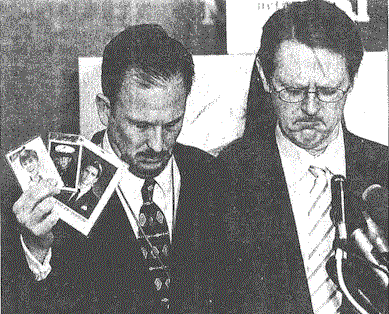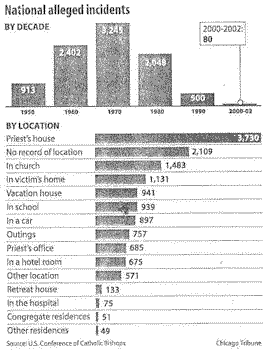Church's Day of Reckoning
Report blames bishops, seminaries in 'shameful' abuse
By Geneive Abdo
Chicago Tribune
February 28, 2004
The U.S. Catholic Church failed to screen candidates effectively for the
ministry and was "shameful" in its handling of abuse allegations
leveled at more than 4,000 priests over the last half-century, according
to most comprehensive analyses to date of the sexual abuse scandal.
 |
| Cardinal Francis George talks to reporters Friday as the Chicago Catholic Archdiocese released its report on sexual abuse of young people by priests over the past half-century. Tribune photo by Bill Hogan. Original in color; reproduced here in b&w. |
The two long-awaited studies released Friday, designed to quantify and explain the abuse problem, represent the church's efforts to show it is confronting the scandal openly and taking measures to prevent future abuse.
But advocacy groups representing the victims said the figures were too low and criticized the reports for failing to identify the priests who were accused or the dioceses that had the greatest number of offenders.
 |
| Survivors Network of those Abused by Priests members Mark Serrano, holding photos of abuse victims who committed suicide, and David Clohessy pause for a moment of silence Friday. AP photo by Ron Edmonds. |
In all, 10,667 people reported they had been abused as minors by a total of 4,392 priests and deacons from 1950 to 2002, according to one of the reports. That figure represents 4 percent of the 109,694 priests in ministry at some point during those years.
"There is absolutely no excuse for what occurred in the Catholic Church," said Robert Bennett, a member of the National Review Board, a watchdog group of lawyers, judges and other professionals that was commissioned by the U.S. Conference of Catholic Bishops to analyze the scandal.
Also Friday, the Chicago archdiocese reported that 55 priests--2 percent of those serving--were involved in 142 credible cases of sexual abuse since 1950. Officials said they planned to make it possible for visitors to the archdiocese Web site to check if a priest was among those accused in Chicago.
Revelations in the reports were certain to prompt more debate within the church over issues that have surfaced since the scandal broke in 2002, including whether celibacy should continue to be a requirement for priests.
 |
Catholic bishops, responding to the reports at a news conference in Washington, vowed to enforce a variety of new measures, including tougher screening of men who want to enter the seminaries.
"Seminaries and religious houses are doing much better screening procedures," said Bishop Wilton Gregory, president of the bishops conference. "The bishops did what they said they would do."
Despite the bishops' optimism that the rate of sex abuse would decrease, observers cautioned that it is too early to predict the future.
"This report tells us something about the scale of the problem that for the time being will have to suffice as the church moves forward," said Scott Appleby, a professor at the University of Notre Dame who is an expert on Catholicism. "The final grade will come years down the road after we have seen a series of annual reports that indicate how diligently the dioceses have been reporting new accusations."
Experts on the church praised the bishops' decision to release comprehensive information on sexual abuse to the public, saying no other profession has conducted such an extensive study. They also noted that the abuse of minors is a national problem not confined to the Catholic Church.
Culture of seminaries 'lax'
But the report on the root causes of the scandal, a 145-page analysis conducted by the National Review Board, says the church was negligent in handling the problem within its own ranks. The report focused in part on the culture of seminaries, which the study described as morally and institutionally "lax."
"There appear to be several reasons why some in the church in the past allowed young men and boys into seminaries who did not belong there," the report said. "One reason may have been that seminaries simply presumed that no one afflicted with a severe sexual dysfunction would have heard the call to the priesthood in the first instance."
The report said that although celibacy is one of the greatest challenges facing most priests, bishops have failed to recognize that or prepare men to handle it.
"It appears that too many priests and too many bishops acted as if celibacy was something that could be imposed as part of the formation process and then taken for granted. ... It is clear that in the hyper-sexualized American society of the past few decades, living a celibate life takes commitment and dedication," the report said.
While placing blame squarely on the bishops and the admissions process in seminaries, the review board's report also said the "permissiveness and moral relativism" in America in the 1970s and 1980s created an atmosphere that encouraged sexual abuse. The greatest numbers of sexual abuse occurred in those decades.
Sexual orientation controversy
At the height of the scandal, some clergy suggested that homosexuals be excluded from the priesthood, sparking outrage from those who argue that sexual orientation is irrelevant to abuse.
The report may add to that controversy, as it criticizes the church for creating an environment that encouraged homosexual behavior. "In particular, there developed at certain seminaries a `gay subculture' and at those seminaries, according to several witnesses, homosexual liaisons occurred among students or between students and teachers," the report said.
The report recommended that additional scrutiny be used by bishops who choose to ordain homosexuals "given the nature of the problem of sexual abuse of minors, the realities of the culture today, and the male-oriented atmosphere of the seminary."
But Appleby of Notre Dame cautioned against reaching the conclusion that homosexuals should be banned from the priesthood.
"I am uncomfortable saying homosexuals are inclined to be sex offenders," said Appleby. It is not a priest's sexual preference, he added, that makes him inclined to be a sex offender but rather an "arrested psychological development."
After learning of the abuse problem, the bishops over the last 25 years tried to downplay it, the report said. "Too many bishops in the United States failed to respond forthrightly and firmly. Their responses were characterized by moral laxity, excessive leniency, insensitivity, secrecy and neglect," the report said.
The report provided several recommendations, including requiring bishops to ensure that each candidate for the seminary is psychologically well adjusted and requiring seminaries to provide better preparation for maintaining a celibate life.
The second report, a statistical study conducted for the review board by the John Jay College of Criminal Justice, part of the City University of New York, identified the 4,392 priests and deacons as sex offenders since 1950. The 11-month study was based on information from 195 dioceses and 142 religious communities in the United States.
Several types of abuse
The types of sexual abuse that priests are alleged to have committed ranged from touching the victim's clothes inappropriately, to hugging and kissing, and other types of sexual assault.
It also found that in 26 percent of the cases, the abuser was dead or not active by the time the charges were substantiated; 22 percent involved an abuser who resigned from ministry, retired or applied to leave the priesthood; and under 4 percent led to the removal of an abuser from the priesthood.
In the remaining 48 percent of cases, the priest was reprimanded, underwent counseling, and was at some point reinstated.
Of the victims, 81 percent were male. About 40 percent of the male victims were between 11 and 14 years old.
Nationwide, the church spent more than $570 million to settle legal claims, according to the reports released Friday. The sex abuse crisis cost the Chicago archdiocese $38.7 million in legal fees and settlements since 1950, officials said.
Advocacy groups for the victims of sex abuse criticized many aspects of the statistical study, saying the methods used to compile the numbers were flawed. John Jay investigators relied upon dioceses around the country to supply information based on their records. But there was no standardized reporting, leaving each diocese to determine which cases should be included.
"The report's dependence on diocesan summaries of diocesan data is a serious weakness," said Terry McKiernan of Survivors First, a victims' advocacy group. "We know that the bishops have lied and destroyed files, so why should they be honest this time?"
Anne Burke, an Illinois Appellate Court judge who chaired the 12-member review board, acknowledged that the church's record keeping was flawed but said the statistical study should be viewed as a good beginning.
"The record keeping is so dysfunctional. This is what was in the records we have," she said. "I'm sure there are a lot of them where the bishop says, `I believe the priest' and just put nothing in the file."
Advocates for the victims also criticized the report for providing only national statistics without a breakdown for each diocese.
Burke said the review board allowed dioceses to file information anonymously, fearing they would not cooperate out of concern of litigation against them. Some dioceses did post their statistics on Web sites in recent weeks. However, their methods differed widely and defied comparison.
"This has been a struggle from the beginning," Burke said.
Tribune staff reporter James Janega contributed to this report.
Any original material on these pages is copyright © BishopAccountability.org 2004. Reproduce freely with attribution.